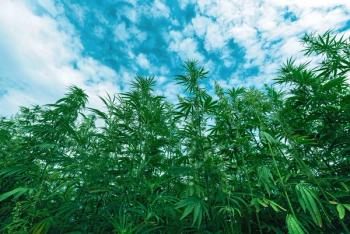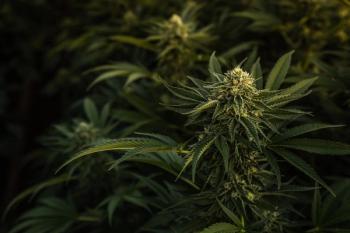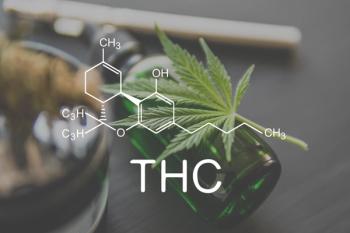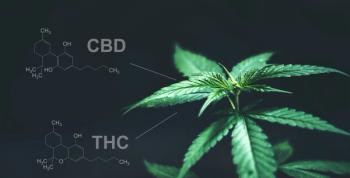
Cannabis Science and Technology
- July/August 2022
- Volume 5
- Issue 6
- Pages: 8-11
Quantitative Spectroscopy: Practicalities and Pitfalls, Part II

Part II of this series discusses how to measure absorbances properly, and compares the use of peak heights and peak areas in creating calibrations.
This column will continue the discussion of the practicalities and pitfalls of quantitative spectroscopy started in the last column (1). The reason that a discussion of quantitative spectroscopy matters for cannabis analysis is that many cannabis potency methods use high performance liquid chromatography (HPLC) along with ultraviolet-visible (UV-vis) spectroscopic detection (2). Also, there exist cannabis potency analyzers based on mid-infrared spectroscopy (3). The fundamental equation of quantitative spectroscopy is Beer’s Law (4), whose form is seen in Equation 1.
where A is the absorbance; ε is the absorptivity, a fundamental physical constant of a molecule; L is the pathlength or sample thickness; and C is the concentration.
I will dispense with any further discussion of Beer’s Law or the basics of quantitative spectroscopy and refer you to my previous columns on these topics (1,5–7). In this installment, we discuss how to measure absorbances properly, and compare the use of peak heights and peak areas in creating calibrations.
Measuring Absorbances Properly
Peak Height
In the spectroscopic literature, and in our discussion of quantitative spectroscopy so far (1,5–7), much ink has been spilled about determining the absorptivity because this is often the unknown quantity we need to determine to finalize a calibration. We have also discussed the importance of measuring concentrations properly (1,5–7). Pathlengths, L, are generally known or fixed so they are typically not a problem. That leaves the final parameter in Beer’s Law: absorbance. To review, we measure the absorbance of standard samples of known concentration to achieve calibrations. What then is the best way to measure this important property?
A tried-and-true way to measure absorbance is the height of a peak in a spectrum (4). The first thing to do in measuring absorbances is to determine which peak to use in your analyte’s spectrum. This is a problem because samples may contain molecules whose peaks can overlap with and interfere with the measurement of the absorbance of the peaks from your analyte. That is, we need to measure the height of a peak that is spectrally isolated and overlaps as little as possible with peaks from any other components in a sample (4). To find a spectrally isolated peak, the first thing to do is consult spectra of the pure materials that make up your sample mixture. This is illustrated in Figure 1.
The four spectra in Figure 1 are of the pure materials isopropanol (IPA), ethanol (EtOH), acetone, and water. Imagine we want to measure the concentration of IPA in a mixture of these four substances. Which peak should we use? An examination of the spectra, seen in Figure 1, shows the IPA peak at 948 cm-1, which is marked in the figure, is mostly clear of interference from peaks of the other molecules in the mixture. If you look closely in Figure 1, you can see the start of a water peak at 948 cm-1, and I discuss how to deal with this later.
Interferent peaks are a fundamental problem with the single peak quantitative method I have been discussing in the pages of this magazine (1,5–7). In the past, this problem limited the use of quantitative spectroscopy (4). Fortunately, with the advent of computers and powerful algorithms accurate concentration determinations using spectroscopy can be made on complex mixtures (4) including hemp and cannabis, cannabis extracts, cannabis distillates, and tinctures (8–13). Alas, a discussion of these algorithms is beyond the scope of this column series. For HPLC analyses using spectroscopic detection, interferent peaks are generally not a problem because the chromatograph breaks the mixture down into its pure components (2).
The next thing to do to insure proper absorbance measurements is to make up your standard samples, measure their spectra, and then overlay them as shown in Figure 2.
This is done to insure the size of the analyte peak of interest changes with concentration. Note in Figure 2 that our IPA peak at 948 cm-1 does change in peak size with concentration, so we can go ahead and use it in our calibration.
A view of our 948 cm-1 peak in one of the standard spectra is seen in Figure 3.
Note that this peak leans to the left, and has a baseline elevated above zero absorbance. It would be tempting to just place your cursor at the top of this peak and measure the absorbance there, but since there is a weak water interference here you would obtain an incorrect absorbance. How do we measure the peak height of such a thing?
The first thing to realize is that when a computer displays a spectrum there is not an absorbance measurement at every possible wavenumber, but there are absorbance values at specific wavenumber values. This is seen in Figure 4 where the red x’s represent the actual absorbance measurements that make up our IPA peak of interest seen in Figure 3.
Instinctively, we tend to want to measure the peak height at its top, but why? Absorbances at other wavenumbers in this peak also change value with analyte concentration as seen in Figure 2. Why don’t we measure our absorbance value at these alternate wavenumbers? Recall our discussion of signal-to-noise ratio (SNR) in a previous column (1), that the SNR for a peak is its peak height divided by the noise level in that spectral vicinity. For a given peak the signal is greatest at the top of the peak, hence measuring peak height at its top will give an absorbance measurement with the best SNR.
How do we deal with our left-leaning peak with an elevated baseline, which can be seen in Figure 3? By the way, non-zero baselines can be caused by instrumental problems or interference from other molecules. Rather than reading the raw peak height, we almost always measure the peak height with respect to a baseline. In Figure 3, the baseline endpoints and baseline are shown in blue. The purpose of the baseline is two-fold. First, by measuring the peak height with respect to the baseline the water contribution to the peak at 948 cm-1 in Figure 3 is eliminated because its contribution falls under the baseline. Second, for a peak like the one in Figure 3 that leans left or right, measuring with respect to a baseline makes sure that only this peak itself and not adjacent portions of the spectrum are used.
The tricky part in this process is establishing the baseline endpoints; that is, at what wavenumbers to locate the beginning and end of the baseline. In Figure 3 the left baseline endpoint is at 968 cm-1, and the right baseline endpoint is at 925 cm-1. Note that the baseline endpoints correspond to the peak edges. How did I choose these? There do exist software programs that can pick peak edges and baseline endpoints, but in my experience a human being—the thing with a brain and eyeballs—can do better. Almost all spectroscopy or chromatography software programs will allow you to visualize a peak and set the baseline endpoints manually. It does take a little training and user interaction to do this properly, but I prefer it to trusting the computer to do things for me. Basically, you should choose baseline endpoints where the peak flattens out and is parallel to the baseline. As it turns out, the height of our peak of interest, the distance between the baseline and the top of the peak at 948 cm-1 represented by the green line in Figure 3, is 0.09 absorbance units. This is the number we would use as part of a Beer’s Law plot to obtain a calibration (5–7).
Peak Area
Some spectroscopic quantitative methods use peak height, others use peak area. We know how peak heights are measured, how are peak areas calculated? It begins the same as measuring a peak height, drawing a correct baseline as seen in Figure 3 above. Now, look at Figure 4. There are 12 wavenumbers with absorbance values between 968 and 925 cm-1. To calculate a peak area for this peak the absorbance at each of these wavenumbers is calculated with respect to the baseline shown in Figure 3, and then these dozen absorbances are added together. Thus, for the peak shown in Figure 3 the area is 1.49 absorbance units using the baseline shown in blue. Note that the peak area value is much greater than the peak height value because the peak height is a single absorbance measurement, whereas in this case the peak area is the sum of 12 absorbance measurements.
Now that we know how peak heights and areas are measured, which one should you use in your calibration? This is actually a complex question and has been a topic of debate in the literature (4). In my last column (1), we discussed that the SNR of a spectrum is a measure of spectral quality, and that it can be calculated by taking an absorbance value and dividing by the noise level. This means that both peak heights and peak areas can be used to calculate a SNR. Which measurement then gives us the best signal-to-noise ratio? For the peak seen in Figure 3, the noise level at a point in the baseline near the peak is 0.0106 absorbance units. Table I shows the results of SNR calculations using this noise value and the peak height and area results discussed above.
Note that the peak area SNR is 140, whereas the peak height SNR is 8.5, a difference of 16.5 times. This is because the peak area value is much greater than the peak height value and in both cases the denominator was the same. Thus, we can conclude that peak areas have better SNRs than peak heights and thus will in general produce more accurate calibrations.
Another reason to use peak areas is less mathematical. By using peak height, which again is a single absorbance measurement, you are literally putting all your eggs in one basket. If for any reason anything is off about this one absorbance measurement, such as variation in interferent absorbances or a noise spike, the accuracy of your entire measurement is shot. Whereas with peak area, if one absorbance is wrong it is averaged out over the other absorbances that comprise the peak, meaning an inaccuracy in one measurement has less effect on the overall measurement than with peak heights. This ability to tolerate an inaccurate measurement and still maintain accuracy is called robustness, a measure of calibration quality that I hope to discuss more in a future column. In our case here it is safe to say that peak area calibrations are more robust than peak height calibrations.
In my opinion, peak areas are better than peak heights for quantitative spectroscopic analyses. However, there do exist examples in the literature where peak height calibrations give better results than peak area. Given this fact my approach to this issue is simple. Try peak area first, and if you run into problems, then try peak height. At the end of the day the samples themselves will determine which route is best.
Conclusions
Since absorbance is one of the parameters in Beer’s Law, it is important to measure it properly. For single peak quantitative methods, the first thing to do is to consult spectra of the pure components in your sample. You will need to pick an analyte peak as free from interference as possible. The next thing to do is look at the spectra of your standards to ensure that your analyte peak varies with analyte concentration. You then need to draw a baseline under your peak, being careful to choose proper baseline endpoints. Then, you need to measure the peak height or area and use it in your calibration. In this author’s opinion, peak area is better because its calibrations have a better signal-to-noise ratio and are more robust than peak height calibrations. However, since on occasion peak height calibrations can be better, the safest route is to try peak area first, and if the accuracy obtained is not sufficient then try peak height.
References
- B.C. Smith, Cannabis Science and Technology 5(5), 8-13 (2022).
- M.W. Giese, M.A. Lewis, L. Giese, and K.M. Smith, Journal of AOAC International 98(6), 1503 (2015).
www.bigsurscientific.com .- B.C. Smith, Quantitative Spectroscopy: Theory and Practice (Elsevier, Boston, Massachusetts, 2002).
- B.C. Smith, Cannabis Science and Technology 5(4), 8-15 (2022).
- B.C. Smith, Cannabis Science and Technology 5(3), 10-14 (2022).
- B.C. Smith, Cannabis Science and Technology 5(2), 10-13 (2022).
- B.C. Smith, M. Lewis, and J. Mendez, “Optimization of Cannabis Grows Using Fourier Transform Mid-Infrared Spectroscopy,” PerkinElmer Application Note (2016).
- B.C. Smith, Cannabis Science and Technology 2(6), 28-33 (2019).
- B.C. Smith, P. Lessard, and R. Pearson, Cannabis Science and Technology 2(1), 48-53 (2019).
- B.C. Smith, Terpenes and Testing, Jan.-Feb. 32 (2018).
- B.C. Smith, Terpenes and Testing, Nov.-Dec. 48 (2017).
- B.C. Smith, C. Fucetola, K. Erhmantraut, and T. Hagan, Terpenes & Testing, Sept./Oct. 19-24 (2020).
About the Columnist
Brian C. Smith, PhD, is Founder, CEO, and Chief Technical Officer of Big Sur Scientific. He is the inventor of the BSS series of patented mid-infrared based cannabis analyzers. Dr. Smith has done pioneering research and published numerous peer-reviewed papers on the application of mid-infrared spectroscopy to cannabis analysis, and sits on the editorial board of Cannabis Science and Technology®. He has worked as a laboratory director for a cannabis extractor, as an analytical chemist for Waters Associates and PerkinElmer, and as an analytical instrument salesperson. He has more than 30 years of experience in chemical analysis and has written three books on the subject. Dr. Smith earned his PhD on physical chemistry from Dartmouth College.
Direct correspondence to:
How to Cite This Article:
B. Smith, Cannabis Science and Technology® Vol. 5(6), 8-11 (2022).
Articles in this issue
over 3 years ago
Concentrate...What Do You Call It?over 3 years ago
Powering CEA: Power Supply Solutions for CEA Facilitiesover 3 years ago
2022 CSC East Plenary Speaker Highlight: Dr. Dedi MeiriNewsletter
Unlock the latest breakthroughs in cannabis science—subscribe now to get expert insights, research, and industry updates delivered to your inbox.




